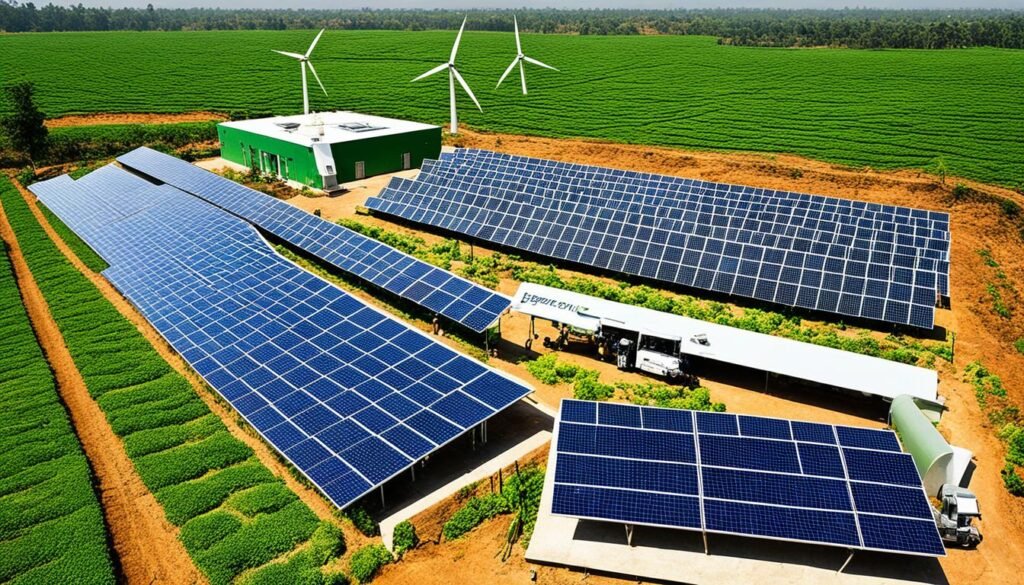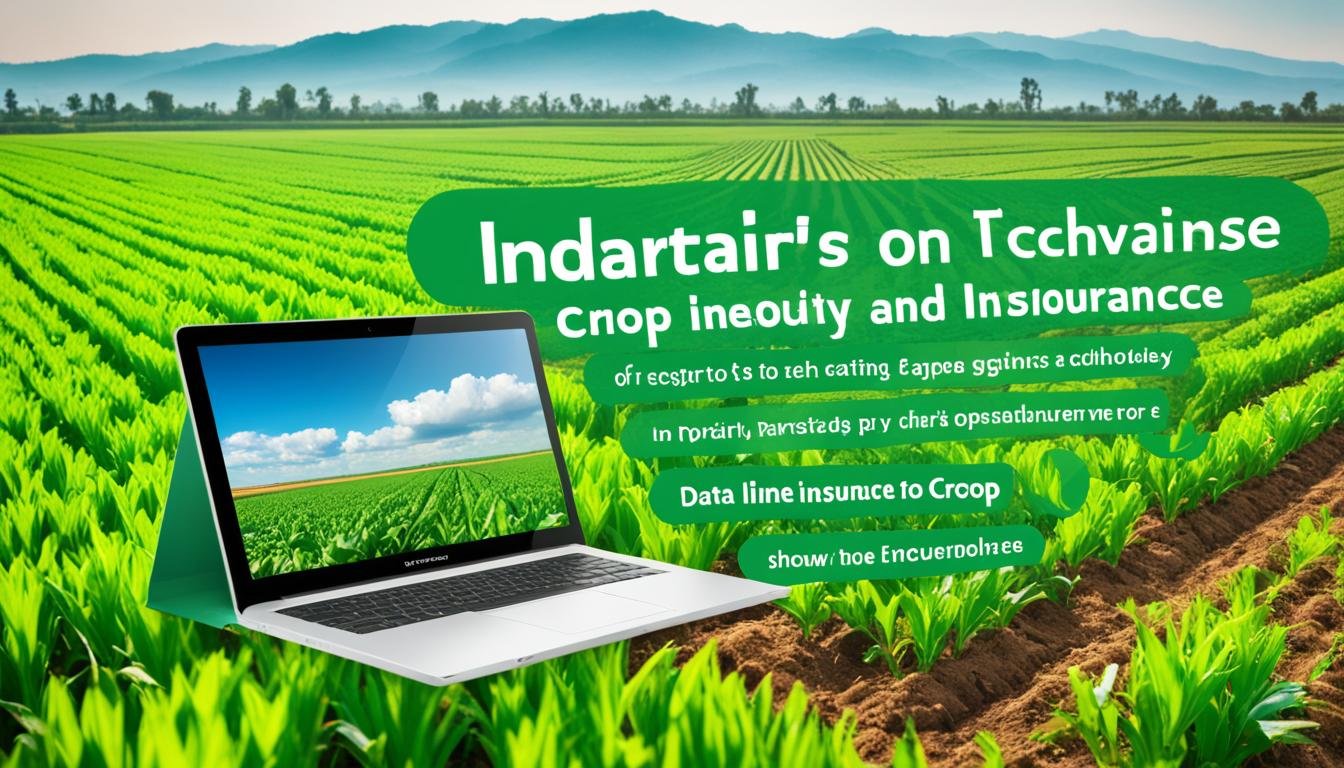Samrakshane is a term that encompasses various eco-friendly practices aimed at nature conservation, environmental protection, and wildlife preservation in India. These practices focus on sustainable approaches to ensure the long-term health and balance of ecosystems, as well as the preservation of biodiversity. In this article, we will explore the innovative eco-friendly practices being implemented in India to promote samrakshane and sustain our planet’s future.
Samrakshane Portal: Digital Innovation in Crop Insurance
The Samrakshane Portal is an innovative technology platform launched in Karnataka, India, to promote and manage crop insurance. It aims to automate the entire process of crop insurance adoption, making it more efficient and accessible for farmers.
Through the adoption of digital innovation, such as data analytics and remote sensing technology, the Samrakshane Portal enables better assessment of risks and losses faced by farmers, leading to improved crop insurance coverage and benefits. By leveraging advanced technologies, this platform revolutionizes the traditional approach to crop insurance, offering farmers a seamless and reliable solution for protecting their vital agricultural assets.
Benefits of the Samrakshane Portal
- Enhanced Efficiency: The Samrakshane Portal automates various processes involved in crop insurance, reducing paperwork, eliminating manual errors, and streamlining operations. This streamlined approach saves time and resources, allowing farmers to focus more on their farming activities.
- Accurate Risk Assessment: With the integration of data analytics and remote sensing technology, the Samrakshane Portal enables accurate assessment of risks and losses faced by farmers. By analyzing satellite imagery, weather patterns, and historical data, the platform provides valuable insights to insurance providers, enabling them to offer customized coverage and premiums based on the actual risks.
- Accessibility and Transparency: The digital interface of the Samrakshane Portal makes it easily accessible to farmers, regardless of their geographical location. It allows farmers to access information related to crop insurance, submit claims, and track the progress of their applications. This transparency fosters trust and confidence among farmers, as they have a clear understanding of the insurance process.
- Better Coverage and Benefits: By leveraging digital innovation, the Samrakshane Portal facilitates prompt settlement of claims and ensures timely disbursement of insurance benefits to farmers. This not only protects farmers from financial losses but also encourages more farmers to adopt crop insurance, contributing to the overall sustainability of agriculture.
In conclusion, the Samrakshane Portal represents a significant digital innovation in the field of crop insurance in India. By automating processes, improving risk assessment, and providing accessibility to farmers, this platform ensures enhanced efficiency, transparency, and better coverage. The utilization of data analytics and remote sensing technology enables farmers to protect their crops effectively, leading to a more resilient and prosperous agricultural sector.
| Benefits of the Samrakshane Portal |
|---|
| Enhanced Efficiency |
| Accurate Risk Assessment |
| Accessibility and Transparency |
| Better Coverage and Benefits |
Challenges and Adoption of PMFBY
The Pradhan Mantri Fasal Bima Yojana (PMFBY) is a crop insurance program introduced by the Indian government in 2016. It was designed to alleviate the burden on smallholder farmers and provide comprehensive coverage for their crops. However, the implementation of PMFBY has faced challenges, particularly in terms of transparency and prompt settlement of claims.
The transparency of the PMFBY scheme has been a major concern, as it is crucial for farmers to have complete visibility into the insurance process, including premium calculation and claim assessment. Additionally, the timely settlement of claims is essential to ensure that farmers receive the financial support they need in the event of crop loss or damage.
However, the adoption of the PMFBY scheme has been steadily increasing, thanks to the introduction of the Samrakshane Portal. This innovative digital platform has significantly improved the efficiency and accessibility of crop insurance. Farmers can now easily access information about the scheme, calculate premiums, and submit claims online, reducing paperwork and administrative hassles.
Furthermore, the Samrakshane Portal leverages technology such as data analytics and remote sensing to assess risks and losses accurately. This enables farmers to receive fair and timely compensation, ensuring that the benefits of crop insurance reach those who need it the most.
Despite the initial challenges, the adoption of PMFBY has gained momentum with the implementation of the Samrakshane Portal. This remarkable digital innovation has transformed the way crop insurance is managed, providing farmers with a more seamless and transparent experience.
The table below highlights the key challenges faced by the PMFBY scheme and the corresponding improvements brought about by the Samrakshane Portal:
| Challenges | Adoption |
|---|---|
| Limited transparency | Improved visibility and understanding of insurance process |
| Slow settlement of claims | Timely compensation through efficient claim submission and processing |
| Complex paperwork and documentation | Streamlined processes through online platforms |
| Inadequate risk assessment | Accurate assessment using technological tools for better coverage |
The introduction of the Samrakshane Portal has addressed these challenges, making crop insurance more accessible and farmer-friendly. It represents a significant step towards achieving the objectives of the PMFBY scheme and ensuring the financial security of smallholder farmers in India.
Impacts of Samrakshane Practices
The implementation of samrakshane practices in India has had significant impacts on sustainable agriculture and ecosystem protection. These practices, such as organic farming, watershed management, and afforestation, have helped conserve natural resources, enhance soil fertility, and reduce the use of harmful pesticides and fertilizers.
“Samrakshane practices have revolutionized the way we approach agriculture in India. By adopting organic farming techniques, we have witnessed a remarkable improvement in soil health and crop yield,” says Dr. Rajendra Kumar, a leading agricultural scientist.
Organic farming, one of the key samrakshane practices, eliminates the use of synthetic chemicals and promotes natural pest control methods. This not only safeguards the health of farmers and consumers but also protects the surrounding ecosystems from the harmful impacts of chemical runoff.
The implementation of watershed management practices has been instrumental in conserving water resources and preventing soil erosion. By constructing check dams, contour bunds, and farm ponds, farmers are able to capture rainwater and recharge groundwater, ensuring a sustainable supply of water for irrigation.
Afforestation initiatives under samrakshane practices have played a vital role in restoring degraded ecosystems and preserving biodiversity. The planting of native tree species helps combat deforestation, reduces carbon emissions, and provides habitats for wildlife.
These sustainable agriculture practices not only benefit the environment but also have a positive impact on the livelihoods of local communities. By promoting the use of organic fertilizers and crop rotation, farmers can reduce input costs, increase their income, and improve the quality of their produce.
Impacts of Samrakshane Practices on Sustainable Agriculture:
- Enhanced soil fertility through organic farming techniques
- Reduction in the use of harmful pesticides and fertilizers
- Conservation of water resources through watershed management
- Prevention of soil erosion and degradation
- Restoration of degraded ecosystems through afforestation
- Preservation of biodiversity and habitats for wildlife
- Promotion of sustainable livelihoods for local communities
The implementation of samrakshane practices in India has paved the way for a more sustainable and resilient agricultural sector. By prioritizing the protection of the environment and embracing innovative techniques, India is moving towards a future where agriculture can coexist harmoniously with nature.

| Impacts | Description |
|---|---|
| Enhanced Soil Fertility | Organic farming practices promote nutrient-rich soil, improve soil structure, and enhance crop yields. |
| Reduced Use of Chemicals | By minimizing the use of harmful pesticides and fertilizers, samrakshane practices protect the environment and human health. |
| Conserved Water Resources | Watershed management techniques help capture rainwater, recharge groundwater, and ensure sustainable irrigation. |
| Restored Ecosystems | Afforestation initiatives restore degraded ecosystems, combat deforestation, and provide habitats for diverse flora and fauna. |
| Promoted Biodiversity | Samrakshane practices conserve biodiversity by preserving native plant species and protecting wildlife habitats. |
| Sustainable Livelihoods | By adopting sustainable practices, farmers can increase their income, reduce input costs, and improve the quality of their produce. |
Integration of Technology and Samrakshane
Technology plays a crucial role in the integration of samrakshane practices, enabling innovative solutions for the preservation of nature and sustainable agriculture in India. The use of advanced technologies such as remote sensing, mobile telephones, and data analytics has revolutionized the way we monitor and manage natural resources, crop yields, and weather patterns.
One remarkable example of this integration is the Samrakshane Portal, which leverages digital innovation to promote eco-friendly practices, particularly in crop insurance. By harnessing the power of technology, the Samrakshane Portal has revolutionized the adoption and management of crop insurance, benefiting farmers and protecting their livelihoods.
Empowering Farmers with Innovative Solutions
Through the integration of technology, farmers now have access to vital information and services at their fingertips. Mobile-based technologies and apps provide real-time updates on weather conditions, crop prices, and farming best practices. This empowers farmers to make informed decisions, adopt sustainable farming techniques, and mitigate risks effectively.
Additionally, remote sensing technology enables the accurate assessment of crop health, pest infestations, and water availability. This data-driven approach allows farmers to optimize resource allocation, minimize input costs, and enhance crop productivity while reducing the environmental impact.
“Technology has transformed the way we approach samrakshane practices. By bridging the gap between farmers and essential services, we are empowering individuals to actively participate in sustainable agriculture and environmental conservation.”
Enhanced Monitoring and Management
Data analytics play a significant role in the integration of technology and samrakshane practices. By analyzing vast amounts of data, experts can identify trends, predict crop yields, and assess environmental impact. This facilitates informed decision-making for farmers, policymakers, and conservationists, empowering them to implement targeted interventions for ecosystem preservation and restoration.
The integration of technology also streamlines the monitoring and management of natural resources. Satellite imagery and sensor-based systems enable the mapping and analysis of land use, water availability, and biodiversity hotspots. This comprehensive understanding of ecosystems allows for better planning, policy formulation, and the implementation of protective measures to safeguard our natural heritage.
Building a Sustainable Future
The integration of technology and samrakshane practices is shaping a sustainable future for India. By providing farmers with accessible information, tools, and services, we can promote the adoption of eco-friendly practices and ensure the long-term preservation of our environment.
Through continued investments in research and development, collaborations between government agencies, private sectors, and research institutions, India is at the forefront of the global movement towards sustainable agriculture and environmental conservation.
As we embrace innovative solutions and harness the power of technology, we pave the way for a greener, more sustainable tomorrow.
Government Initiatives and Support
The Indian government is committed to promoting samrakshane through various initiatives and support mechanisms. Recognizing the importance of eco-friendly practices for sustainable development, the government has implemented a range of measures to encourage their adoption across different sectors.
“We believe that by investing in samrakshane, we can ensure a greener future for India,”
One of the key government initiatives is the provision of financial incentives. These incentives aim to motivate individuals and organizations to embrace eco-friendly practices by offering monetary benefits or subsidies. By reducing the financial burden associated with adopting such practices, the government hopes to make them more accessible and attractive to a wide range of stakeholders.
In addition to financial support, the government has also launched research and development programs to drive innovation in samrakshane. These programs provide funding and resources for research institutions and technology companies to develop and implement cutting-edge solutions that can further enhance environmental conservation efforts.
Capacity building and policy reforms
Moreover, the government recognizes the importance of capacity building in driving the adoption of eco-friendly practices. It has established training programs and workshops to educate and empower individuals, communities, and organizations on the benefits and techniques of samrakshane.
Furthermore, the government has undertaken policy reforms to create an enabling environment for the widespread adoption of eco-friendly practices. By implementing supportive policies and regulations, it aims to remove barriers and incentivize industries and communities to embrace sustainable practices.
Government initiatives are not limited to isolated efforts. Recognizing the complexity and multidisciplinary nature of samrakshane, government agencies collaborate with research institutions, non-governmental organizations (NGOs), and local communities to implement and monitor eco-friendly initiatives. This collaborative approach ensures that initiatives are well-coordinated, effectively implemented, and have a meaningful impact on the environment and society.
To illustrate the impact of government initiatives and support for samrakshane, let’s take a look at a table showcasing some key programs and measures:
| Government Initiative | Description |
|---|---|
| Financial Incentives | Monetary benefits and subsidies to encourage the adoption of eco-friendly practices |
| Research and Development Programs | Funding for research institutions and technology companies to develop innovative solutions |
| Capacity Building | Training programs and workshops to educate and empower stakeholders on samrakshane practices |
| Policy Reforms | Implementation of supportive policies and regulations to incentivize sustainable practices |
| Collaboration with Research Institutions and NGOs | Partnerships to implement and monitor initiatives for effective and coordinated outcomes |
Through these initiatives and support mechanisms, the Indian government is playing a vital role in promoting samrakshane and creating a sustainable future for generations to come.

Conclusion
In conclusion, samrakshane practices are playing a pivotal role in promoting eco-friendly practices in India. Through the integration of technology, strong government support, and the adoption of sustainable approaches, the country is making significant progress in nature conservation, environmental protection, and wildlife preservation.
The implementation of the Samrakshane Portal and other innovative solutions has greatly enhanced the efficiency and accessibility of crop insurance, benefiting farmers across the nation. By leveraging advanced technologies, such as data analytics and remote sensing, the Samrakshane Portal has revolutionized the process of assessing risks and losses faced by farmers, leading to improved coverage and better support for their livelihoods.
With continued efforts and collaboration between government agencies, research institutions, NGOs, and local communities, India is moving towards a greener and more sustainable future. The adoption of samrakshane practices not only helps conserve natural resources and enhance soil fertility but also contributes to the preservation of biodiversity and the restoration of degraded ecosystems. This holistic approach ensures the long-term sustainability of agriculture and promotes resilient communities.
FAQ
What is samrakshane?
Samrakshane is a term that encompasses various eco-friendly practices aimed at nature conservation, environmental protection, and wildlife preservation in India.
What is the Samrakshane Portal?
The Samrakshane Portal is an innovative technology platform launched in Karnataka, India, to promote and manage crop insurance.
How does the Samrakshane Portal work?
The Samrakshane Portal automates the entire process of crop insurance adoption, making it more efficient and accessible for farmers. It utilizes digital innovation, such as data analytics and remote sensing technology, to assess risks and losses faced by farmers and improve crop insurance coverage.
What is the Pradhan Mantri Fasal Bima Yojana (PMFBY)?
The Pradhan Mantri Fasal Bima Yojana (PMFBY) is a crop insurance program introduced by the Indian government in 2016 to reduce the burden on smallholder farmers and provide comprehensive coverage.
What challenges did the PMFBY face?
The PMFBY initially faced challenges in terms of transparency and prompt settlement of claims.
How has the Samrakshane Portal improved the PMFBY?
The implementation of the Samrakshane Portal has improved the efficiency and accessibility of the PMFBY, addressing some of the challenges faced by the program.
What impacts have samrakshane practices had?
Samrakshane practices have had significant impacts on sustainable agriculture and ecosystem protection, including conserving natural resources, enhancing soil fertility, reducing the use of harmful pesticides, preserving biodiversity, restoring degraded ecosystems, and promoting sustainable livelihoods for local communities.
How does technology integrate with samrakshane practices?
Technology, such as remote sensing, mobile telephones, and data analytics, plays a crucial role in monitoring and managing natural resources, crop yields, and weather patterns. Innovative solutions, like the Samrakshane Portal and mobile-based technologies, make information and services more accessible to farmers, empowering them to adopt sustainable practices and mitigate risks effectively.
What are some government initiatives and support for samrakshane?
The Indian government actively promotes samrakshane through financial incentives, research and development programs, capacity building, policy reforms, and collaborations with research institutions, NGOs, and local communities.





